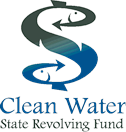Clean Water State Revolving Fund Program
Funding a variety of projects and activities that help states and communities address the most pressing water quality needs and build system resilience.
On this page:
- About the Program
- Types of Assistance
- How This Program Helps Build Resilience
- Connections to Other EPA, Federal, or Non-Governmental Efforts
About the Program
The Clean Water State Revolving Fund (CWSRF) is a low-interest source of financing for wastewater infrastructure and water quality projects. The program is a partnership between the EPA and the states, as well as Puerto Rico.
The state- and territory-administered programs each operate like banks, with federal and state contributions used to capitalize the programs. These funds are used to make low-interest loans to local communities for water quality projects and are then repaid to the CWSRFs.
The Bipartisan Infrastructure Law allocated $11.7 billion to the CWSRF in addition to regular annual appropriations; this funding will help increase climate resilience. The EPA’s March 2022 memorandum “Implementation of the Clean Water and Drinking Water State Revolving Fund Provisions of the Bipartisan Infrastructure Law” encourages states to use the significant increase in SRF funding for infrastructure projects that make water systems more resilient to all threats – including climate change. The memo addresses climate adaptation, encouraging states to “support water, wastewater, and stormwater infrastructure projects that apply the best available and most geographically relevant climate information, projections, and standards, such as the Federal Flood Risk Management Standard.” According to the memo, “states should consider how to incorporate climate resilience criteria into their prioritization of SRF funding under the BIL.”
Types of Assistance
Infrastructure challenges include needs for repair, upgrade, and replacement, as well as to ensure that assets and communities are resilient to the impacts of climate change. The CWSRFs provide assistance for a wide range of eligible activities that can help communities become more resilient and mitigate climate change. Eligible climate resilient and mitigation projects can be standalone or part of a larger water infrastructure project, including green infrastructure; nature-based solutions such as tidal wetlands and living shorelines; emergency response and mitigation plans; and energy efficiency upgrades and renewable energy generation projects. In addition, to the extent that there are sufficient eligible project applications, all CWSRF programs are required to use a portion of their federal grant for Green Project Reserve projects that address green infrastructure, water and energy efficiency, or other environmentally innovative activities.
Financial Assistance
- Each CWSRF program has a unique priority-setting system that evaluates and ranks projects. Ranking criteria primarily focus on public health and water quality but can also address other concerns, such as infrastructure resilience.
- States can encourage more projects that promote system resilience through targeted ranking criteria (e.g., offering priority points) and funding incentives (e.g., reduced interest rates and/or waiving fees).
Technical Assistance
- CWSRF can help communities analyze infrastructure needs, for example assessing a treatment works’ vulnerability to extreme weather or analyzing the best approach to integrate system and community resilience priorities.
- Technical assistance such as water/energy audits, asset management plans, and drought management plans can result in a pipeline of sustainable projects that are eligible for CWSRF funding.
How This Program Helps Build Resilience
Resilience features related to energy and water efficiency upgrades, stormwater management, agricultural conservation practices, and green infrastructure are often incorporated into larger projects that can strengthen and protect traditional water infrastructure. Some of the eligible types of resilience projects help to:
- Prevent interruption of collection system operations.
- Maintain the operation of treatment works and the integrity of the treatment.
- Preserve and protect treatment works.
- Enhance community resilience through stormwater management using both green and gray infrastructure.
- Secure and conserve local water supplies through water reuse and water conservation.
- Encourage climate-smart agriculture (e.g., riparian forest buffers, methane digesters).
- Reduce impairment of water quality (including drinking water source protection) from extreme rain runoff, sedimentation, and mudslides caused by wildfire through improved forest management activities such as forest thinning.
Connections to Other EPA, Federal, or Non-Governmental Efforts
The EPA and the Federal Emergency Management Agency (FEMA) have an MOU that establishes a framework for EPA-funded SRF programs to assist and collaborate with FEMA disaster assistance grant programs. Benefits include:
- Cooperation among the SRFs, FEMA, and state, local, Tribal, and territorial governments to allow local entities to quickly recover and restore their vital infrastructure after a Presidentially declared disaster.
- Better coordination between FEMA and the SRFs to fund essential infrastructure projects as quickly as possible.
- Access to the necessary tools that can help communities increase their resilience to future disasters.
CWSRF funds can leverage funding from other CWA programs to achieve common goals. States can use CWSRF funds with Drinking Water State Revolving Fund (DWSRF) and Section 319 Nonpoint Source funding to conduct assessments, complete applications, or implement nonpoint source pollution projects (pdf).
More information on how the CWSRFs can fund resilience projects is available here:
- Funding Resilient Infrastructure and Communities with the Clean Water State Revolving Fund
- Funding Drought Resiliency Projects with the Clean Water State Revolving Fund (pdf)
- Funding Wildfire Resiliency, Mitigation, and Recovery Projects with the Clean Water and Drinking Water State Revolving Funds (pdf)
- Increasing Climate Resilience and Mitigation with the Clean Water State Revolving Fund and Water Infrastructure Finance and Innovation Act Program (pdf)

